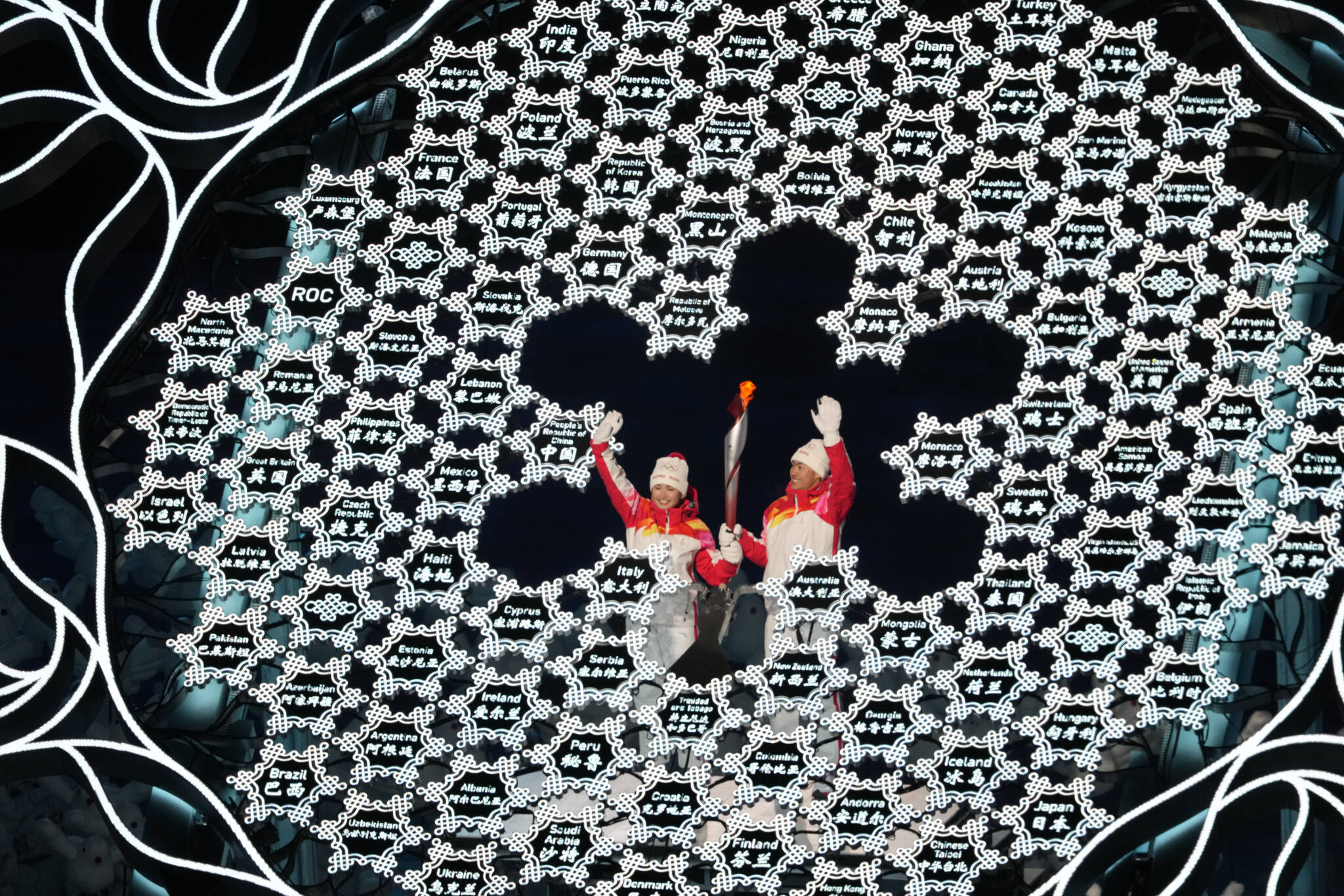A crowd gathered on the stadium floor, dozens of people holding luminescent green poles, waving them overhead like giant blades of grass in a spring breeze.
A child blew on a dandelion, sending white seeds into the air as fireworks streamed through the night sky.
The opening ceremony for the 2022 Beijing Olympics featured no big dance numbers, no pop stars or professional actors. Organizers instead gathered a cast of common people from across China — many of them young — to convey a theme of community and pastoral calm.
Whether intentional or not, the message stood in contrast to a Games beset by noise and turmoil on all sides.
With a scattering of athletes, including some big names, already testing positive for the coronavirus, there are doubts about competition proceeding without major disruption. More important, activists worldwide have protested the decision to stage this event in a country accused of committing human rights abuses against Muslim Uyghurs and other ethnic minorities.
The U.S. and several of its closest allies expressed their disapproval by declining to send a customary delegation to the famed Bird’s Nest stadium on Friday night. The president of the International Olympic Committee sounded defiant when talking about his hope for the next two weeks.
“We can only achieve this mission to unite everybody in this peaceful competition if the Olympic Games stand above and beyond all political disputes,” Thomas Bach told reporters this week. “This is also only possible if the Olympic Games and the IOC are politically neutral and do not become a tool to achieve political goals.”
The two-hour-plus ceremony included no references to Uyghurs or the Hong Kong protests that China has cracked down on. The pandemic was mentioned only a few times, during official speeches near the end.
The motto for these Games, “Together for a Shared Future,” took shape through snowflakes (a leitmotif in numerous set pieces), video presentations and the placards that preceded each team in the parade of nations.
“All snowflakes are different, but together they make a beautiful winter,” the producers explained. “This is like all the people that come to the Winter Olympics.”
If the production was heavy on symbolism, it had a reputation to uphold.
Beijing is the first city to host both the Summer and Winter Olympics and its opening ceremony for the 2008 Games ranks among the best ever. With a reported budget of $100 million and a cast of 15,000 performers, it sought to announce China as an emerging global leader.
A memorable scene included 2,008 drummers pounding on ancient percussion instruments in unison.
“Those drummers really hooked up with the notion of an arriving power,” said Susan Brownell, a professor at the University of Missouri-St. Louis who specializes in Chinese sports culture. “It showed a country that is well-organized and disciplined.”
The director of that show, Zhang Yimou, was brought back to oversee this winter ceremony. He spoke about adjusting his artistic vision in a time of pandemic.
“How to create a wonderful ceremony under conditions that are relatively safe and simple,” Yimou said in a statement, “is a great challenge for us.”
Whatever the circumstances, host countries like to use their moment in the Olympic spotlight to convey messages of national pride. With China’s international status firmly established, and potential setbacks all around, these Games called for a slightly more reserved tone.
“What China is anxious to demonstrate now is that 2008 was no fluke and the country has only advanced since then,” said Clayton Dube, director of the U.S.-China Institute at the University of Southern California. “Even with all these challenges, they want to prove they are able to host major events.”
Throughout the chilly night, as temperatures dipped a few degrees below freezing, there was an emphasis on technology with ever-shifting images playing across a field covered in 124,000 square-feet of HD LED tiles.
In one segment, a giant, simulated block of ice rose from the stadium floor and disintegrated into glimmering Olympic rings. In another, clusters of children scampered around, their footsteps triggering images of stars and, again, snowflakes by way of live-motion capture technology.
There were several effective videos, including one that showed everyday people mimicking athletes and another of children playing in the snow.
If the climax was less impressive, with former Chinese athletes delivering an Olympic cauldron no larger than a torch, it nonetheless drew roars from a surprisingly large crowd. The “select group” of spectators that officials allowed into the stadium — a pandemic-related restriction — appeared to fill a third or more of the seats.
Given all that Beijing has faced, Bach’s welcome to the athletes could have applied to the Games themselves.
“You have arrived here after overcoming so many challenges, living through great uncertainty,” he said. “But now your moment has come: the moment you have been longing for — the moment we all have been longing for.”
—David Wharton Los Angeles Times
RELATED: Curlers right the ship, figure skaters struggle as Canada seeks to defend gold medals
WHAT CANADA DID ON FRIDAY
Curling
Mixed Doubles — Rachel Homan of Beaumont, Alta., and John Morris, Canmore, Alta., improved their record to 3-1 with a 7-5 victory over Switzerland and an 8-6 decision over China.
Figure Skating
Mixed team event — Roman Sadovsky of Vaughan, Ont., placed eighth in his short program with 71.06 points Piper Gilles, Toronto, and Paul Poirier, Unionville, Ont., were fourth in the rhythm dance (82.72) Kirsten Moore-Towers, St. Catharines, Ont., and Michael Marinaro, Sarnia, Ont., were fifth with their short program (67.34). After three disciplines, Canada is ranked sixth overall in qualifying and needs Madeline Schizas of Oakville, Ont., to elevate them on Sunday into the top five positions in order to defend the gold-medal won in South Korea.
Opening Ceremony
Flag-bearers Marie-Philip Poulin of Beauceville, Que. (hockey), and Charles Hamelin, Sainte-Julie, Que. (short-track speed skating), led approximately 90 of the 215 Canadian-strong contingent into the stadium

